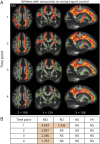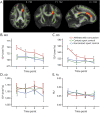Longitudinal white-matter abnormalities in sports-related concussion: A diffusion MRI study
- PMID: 32641518
- PMCID: PMC7605507
- DOI: 10.1212/WNL.0000000000009930
Longitudinal white-matter abnormalities in sports-related concussion: A diffusion MRI study
Abstract
Objective: To study longitudinal recovery trajectories of white matter after sports-related concussion (SRC) by performing diffusion tensor imaging (DTI) on collegiate athletes who sustained SRC.
Methods: Collegiate athletes (n = 219, 82 concussed athletes, 68 contact-sport controls, and 69 non-contact-sport controls) were included from the Concussion Assessment, Research and Education Consortium. The participants completed clinical assessments and DTI at 4 time points: 24 to 48 hours after injury, asymptomatic state, 7 days after return-to-play, and 6 months after injury. Tract-based spatial statistics was used to investigate group differences in DTI metrics and to identify white-matter areas with persistent abnormalities. Generalized linear mixed models were used to study longitudinal changes and associations between outcome measures and DTI metrics. Cox proportional hazards model was used to study effects of white-matter abnormalities on recovery time.
Results: In the white matter of concussed athletes, DTI-derived mean diffusivity was significantly higher than in the controls at 24 to 48 hours after injury and beyond the point when the concussed athletes became asymptomatic. While the extent of affected white matter decreased over time, part of the corpus callosum had persistent group differences across all the time points. Furthermore, greater elevation of mean diffusivity at acute concussion was associated with worse clinical outcome measures (i.e., Brief Symptom Inventory scores and symptom severity scores) and prolonged recovery time. No significant differences in DTI metrics were observed between the contact-sport and non-contact-sport controls.
Conclusions: Changes in white matter were evident after SRC at 6 months after injury but were not observed in contact-sport exposure. Furthermore, the persistent white-matter abnormalities were associated with clinical outcomes and delayed recovery time.
Copyright © 2020 The Author(s). Published by Wolters Kluwer Health, Inc. on behalf of the American Academy of Neurology.
Figures





Comment in
-
White matter and concussion: Are we on the right tract?Neurology. 2020 Aug 18;95(7):279-280. doi: 10.1212/WNL.0000000000009934. Epub 2020 Jul 8. Neurology. 2020. PMID: 32641519 No abstract available.
References
-
- Langlois JA, Rutland-Brown W, Wald MM. The epidemiology and impact of traumatic brain injury: a brief overview. J Head Trauma Rehabil 2006;21:375–378. - PubMed
-
- McCrea M, Guskiewicz KM, Marshall SW, et al. . Acute effects and recovery time following concussion in collegiate football players: the NCAA Concussion Study. JAMA 2003;290:2556–2563. - PubMed
-
- McCrory P, Meeuwisse W, Dvorak J, et al. . Consensus statement on concussion in sport: the 5(th) International Conference on Concussion in Sport held in Berlin, October 2016. Br J Sports Med 2017;51:838–847. - PubMed
-
- Kamins J, Bigler E, Covassin T, et al. . What is the physiological time to recovery after concussion? A systematic review. Br J Sports Med 2017;51:935–940. - PubMed
Publication types
MeSH terms
Grants and funding
LinkOut - more resources
Full Text Sources
Medical
Miscellaneous
